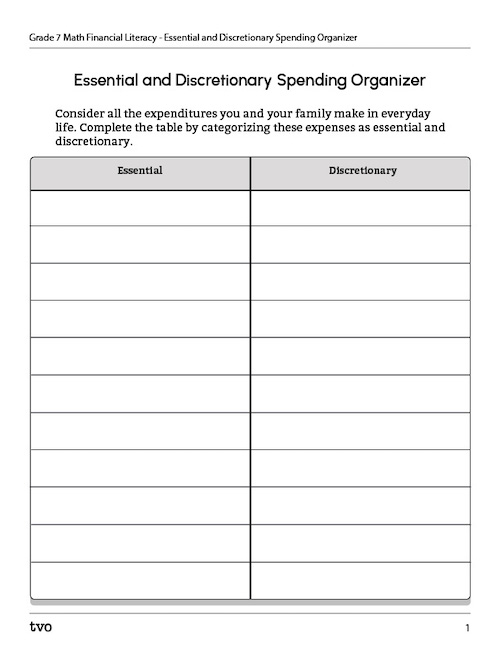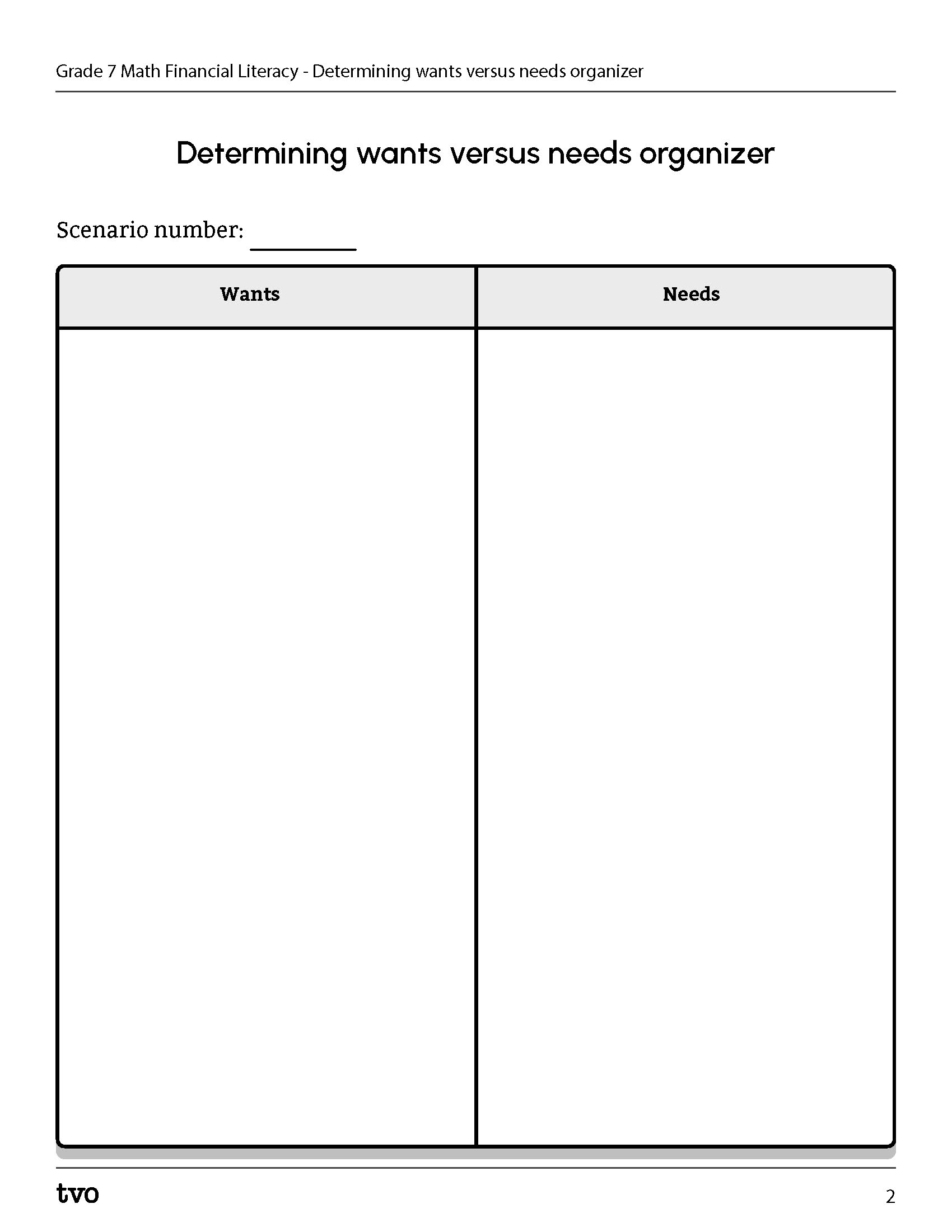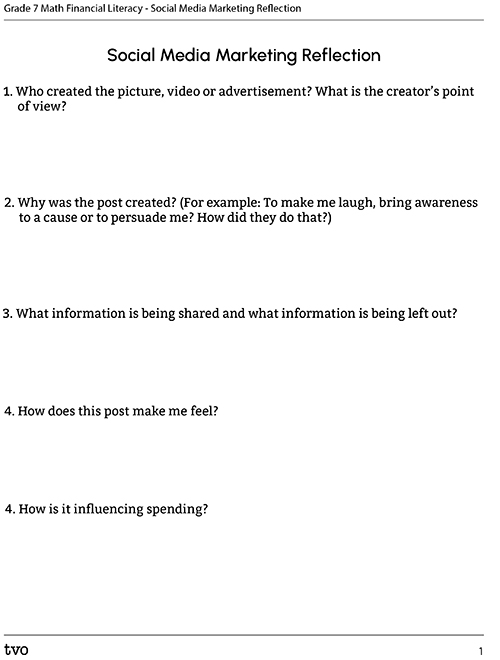Minds On
Making financial decisions

Brainstorm
Brainstorm
Work with a partner, if possible, and brainstorm the following questions:
- What factors affect where you spend money?
- How do you decide what to spend money on?
- How much time do you spend deciding on a purchase? Does the cost of it change the time you need to think about it?
- How do the people around you affect how you spend money?
- Is there something you spend money on no matter the cost? Explain.
Be ready to share your ideas!

Action
Spending within your means
When we think about spending money, it may sound like a simple rule to just spend what a person can afford or what their budget allows based on their source of income. Many North Americans spend more than they save which results in debt. Sometimes a budget is not enough.
It is also important to distinguish between a person’s needs and their wants. Essential spending is spending on someone’s needs. Discretionary spending is spending on someone’s wants.
Complete the Essential and Discretionary Spending Organizer in your notebook or using the following fillable and printable document.
Consider all the expenditures you and your family make in everyday life. Complete the table by categorizing these expenses as essential and discretionary.
| Essential | Discretionary |
|---|---|

Press the Activity button to access the Essential and Discretionary Spending Organizer.
Activity (Open PDF in a new tab)Brainstorm
Brainstorm
What strategies can help someone prioritize where to spend their money first and not use up all or more than their income?
Be ready to share your ideas!
Want versus need scenarios
Consider the following scenarios. Choose one of the scenarios and distinguish the individual’s wants from their needs and help them decide on how to spend their money.
Scenario 1: Student A just graduated from college and their aunt gave them $500.00 as a gift. They want to use it to buy new clothes and a watch because they are also starting a new job in a couple of weeks. Next month they are moving into an apartment on their own and must pay the first three months of their rent which is $1,400.00. Student A plans on using their first paycheck to pay the rent amount. They have a student loan to start paying as well but have not sat down with the bank yet to discuss their payment schedule.

Scenario 2: Student B’s friends invited them to go camping for the long weekend. They will be driving 9 hours away. They estimate the cost of gas, food, and camping will be about $350.00. They have a $270.00 car payment coming up and must pay their cell phone bill of $90.00 at the end of the month. Student B’s mom’s birthday is next week, and they plan to spend $60.00 on a gift for her. They currently have $750.00 in their savings account.

Complete the Determining Wants Versus Needs Organizer in your notebook or using the following fillable and printable document.
Choose one of the scenarios and identify the wants and needs for the student. Complete the table by listing the wants and needs with justification.
Scenario number: (Blank)
| Wants | Needs |
|---|---|

Press the Activity button to access the Determining Wants Versus Needs Organizer.
Activity (Open PDF in a new tab)Consolidation
Influencer marketing
Social media plays a big part in the lives of children and teens. They spend a lot of time following and viewing individuals that pose in certain clothing brands, give makeup tutorials, or open boxed toys to show how they work. The more our lives go digital, the more popular influencer marketing becomes. Social media influencers are paid to persuade viewers to like, follow and want to purchase the products they promote. Influencer marketing pushes us to spend money that feed our wants instead of our needs. Being aware of how we can be easily influenced can help us reflect before wanting and then buying products. How can we be more financially responsible?

Social media marketing reflection
Find a social media post of your choice that markets or promotes a product or influences us to want something. If you are not engaged in social media, you can choose to explore print or digital advertisements or commercials.
Complete the Social Media Marketing Reflection in your notebook or using the following fillable and printable document.
Reflect on the following questions:
- Who created the picture, video or advertisement? What is the creator’s point of view?
- Why was the post created? (For example: To make me laugh, bring awareness to a cause, or to persuade me? How did they do that?)
- What information is being shared and what information is being left out?
- How does this post make me feel?
- How is it influencing spending?

Press the Activity button to access the Social Media Marketing Reflection.
Activity (Open PDF in a new tab)Reflection
As you read the following descriptions, select the one that best describes your current understanding of the learning in this activity. Press the corresponding button once you have made your choice.
I feel...
Now, expand on your ideas by recording your thoughts using a voice recorder, speech-to-text, or writing tool.
When you review your notes on this learning activity later, reflect on whether you would select a different description based on your further review of the material in this learning activity.
Connect with a TVO Mathify tutor
Think of TVO Mathify as your own personalized math coach, here to support your learning at home. Press ‘TVO Mathify’ to connect with an Ontario Certified Teacher math tutor of your choice. You will need a TVO Mathify login to access this resource.
TVO Mathify(Opens in new window)